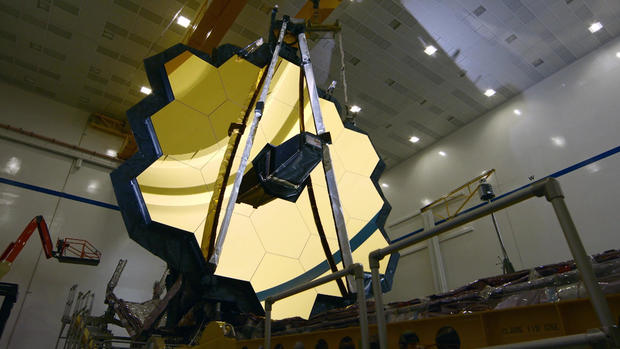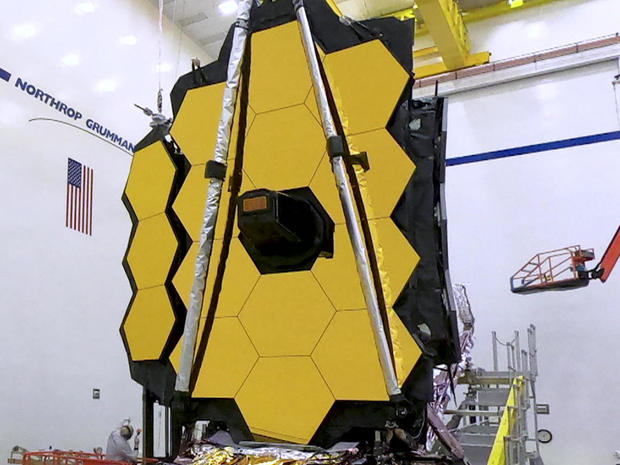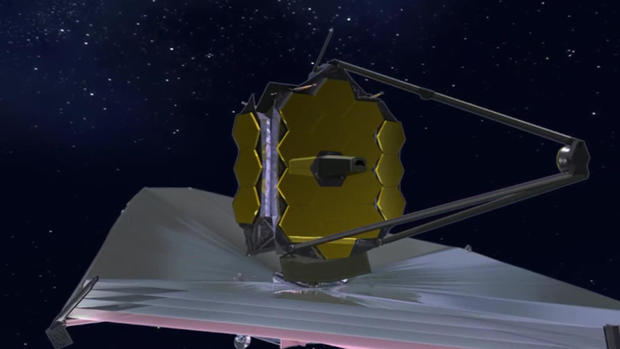18.11.2021

NASA Invites Media to Webb Telescope Science Briefings
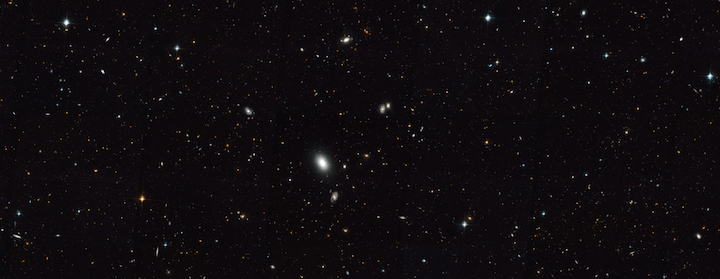
NASA will hold two virtual media briefings Thursday, Nov. 18, on the science goals and capabilities of the James Webb Space Telescope.
Participants will preview how the world’s largest and most powerful space science telescope will build on the discoveries of other missions to answer fundamental questions about the universe and its origins. Participants will also discuss Webb’s four scientific instruments, designed to study a wide range of objects in space, from planets and stars to galaxies and dark energy.
The briefings will livestream on NASA TV, the NASA app, and the agency’s website. All times are provided in Eastern.
11 a.m. – Briefing on Webb’s science goals with the following participants:
- Greg Robinson, Webb program director, NASA Headquarters in Washington
- John Mather, Webb senior project scientist, NASA’s Goddard Space Flight Center in Greenbelt, Maryland
- Antonella Nota, Webb project scientist and head of the ESA (European Space Agency) office at the Space Telescope Science Institute
- Sarah Gallagher, science advisor to the president, Canadian Space Agency
- Klaus Pontoppidan, Webb project scientist, Space Telescope Science Institute
- Amber Straughn, Webb deputy project scientist for communications, Goddard
2 p.m. – Briefing on Webb’s science instruments with the following participants:
- Eric Smith, Webb program scientist, NASA Headquarters
- Lee Feinberg, Webb optical telescope element manager, Goddard
- Marcia Rieke, principal investigator for Webb’s Near-Infrared Camera, University of Arizona
- Pierre Ferruit, principal investigator for Webb’s Near-Infrared Spectrograph, ESA
- Gillian Wright, European principal investigator for Webb’s Mid-Infrared Instrument, U.K. Astronomy Technology Centre
- René Doyon, principal investigator for Webb’s Near-Infrared Imager and Slitless Spectrograph and Fine Guidance Sensor, University of Montreal
To participate by telephone, media must RSVP no later than two hours before the start of each briefing to Alise Fisher at: alise.m.fisher@nasa.gov. Media and members of the public may also ask questions on social media using #NASAWebb.
NASA’s media accreditation policy for virtual and onsite activities is available online.
NASA’s Curious Universe podcast also will debut a special Webb mini-series Tuesday, Nov. 23, exploring the mission’s science, engineering, people, and launch. NASA will release episodes every Tuesday leading up to Webb’s Dec. 18 launch. The trailer is available online.
The Webb telescope, an international partnership with the European and Canadian space agencies, will explore every phase of cosmic history – from within our solar system to the most distant observable galaxies in the early universe, and everything in between. Webb will reveal new and unexpected discoveries, and help humanity understand the origins of the universe and our place in it.
Quelle: NASA
+++
The James Webb Space Telescope Observatory
The Observatory of the James Webb Space Telescope is comprised of three elements: the Integrated Science Instrument Module (ISIM), the Optical Telescope Element (OTE), which includes the mirrors and backplane, and the Spacecraft Element, which includes the Spacecraft Bus and Sunshield.
The Integrated Science Instrument Module (ISIM) includes Webb's science instruments. The OTE is the eye of the Observatory and it gathers the light coming from space and provides it to the science instruments located in the ISIM. The backplane is like the Webb's "spine". It supports the mirrors.
The sunshield subsystem separates the observatory into a warm sun-facing side (spacecraft bus) and a cold anti-sun side (OTE and ISIM). The sunshield keeps the heat of the Sun, Earth, and spacecraft bus electronics away from the OTE and ISIM so that these pieces of the Observatory can be kept very cold (The operating temperature has to be kept under 50 kelvins or -370 deg F).
The Spacecraft Bus provides the support functions for the operation of the Observatory. The bus houses the six major subsystems needed to operate the spacecraft: the Electrical Power Subsystem, the Attitude Control Subsystem, the Communication Subsystem, the Command and Data Handling Subsystem, the Propulsion Subsystem, and the Thermal Control Subsystem.
The momentum flap balances the solar pressure on the sunshield, like a trim flap in sailing. It's not adjustable on orbit, but it is while it's on the ground.
More Information About the Observatory Elements:
- Integrated Science Instrument Module (ISIM)
- Optical Telescope Element (OTE), mirrors, and backplane
- Spacecraft Element (Spacecraft Bus and Sunshield)
The ISIM includes the following instruments:
- Near-Infrared Camera, or NIRCam, - provided by the University of Arizona
- Near-Infrared Spectrograph, or NIRSpec - provided by ESA, with components provided by NASA/GSFC.
- Mid-Infrared Instrument, or MIRI - provided by the European Consortium with the European Space Agency (ESA), and by the NASA Jet Propulsion Laboratory (JPL)
- Fine Guidance Sensor/Near InfraRed Imager and Slitless Spectrograph , or FGS/NIRISS- provided by the Canadian Space Agency
Quelle: NASA
----
Update: 23.11.2021
.
Latest update on Webb telescope launch
The launch readiness date for the James Webb Space Telescope is moving to no earlier than Dec. 22 to allow for additional testing of the observatory, following a recent incident that occurred during Webb's launch preparations.
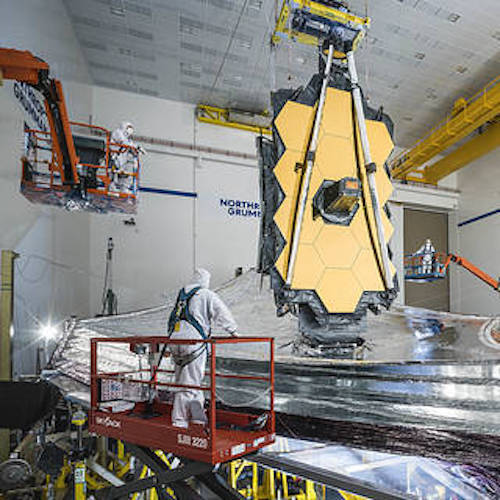
The incident occurred during operations at the satellite preparation facility in Kourou, French Guiana, performed under Arianespace overall responsibility. Technicians were preparing to attach Webb to the launch vehicle adapter, which is used to integrate the observatory with the upper stage of the Ariane 5 rocket. A sudden, unplanned release of a clamp band – which secures Webb to the launch vehicle adapter – caused a vibration throughout the observatory.
A NASA-led anomaly review board was immediately convened to investigate and instituted additional testing to determine with certainty the incident did not damage any components. NASA and its mission partners will provide an update when the testing is completed at the end of this week.
Webb was previously scheduled to launch Dec. 18 on an Arianespace Ariane 5 rocket from Kourou.
The Webb Space Telescope is an international partnership with the European and Canadian space agencies. It will explore every phase of cosmic history – from within our solar system to the most distant observable galaxies in the early universe, and everything in between. Webb will reveal new and unexpected discoveries, and help humanity understand the origins of the universe and our place in it.
Quelle: arianespace
+++
Launch of new NASA space telescope delayed after incident
The European Space Agency says the launch of a new NASA telescope to replace the famed Hubble observatory is being postponed to allow experts to check the device for possible damage following an incident at its spaceport in French Guiana
BERLIN -- The European Space Agency says the launch of a new NASA telescope to replace the famed Hubble observatory is being postponed to allow experts to check the device for possible damage following an incident at its spaceport in French Guiana.
The ESA said in a statement late Monday that technicians had been preparing to attach the James Webb Space Telescope to a launch vehicle adapter when a clamp band suddenly loosened, jolting the delicate observatory.
“A NASA-led anomaly review board was immediately convened to investigate and instituted additional testing to determine with certainty (that) the incident did not damage any components,” ESA said. “NASA and its mission partners will provide an update when the testing is completed at the end of this week.”
ESA said the telescope will now launch aboard an Ariane 5 rocket no earlier than Dec. 22 — four days after the original planned liftoff date of Dec. 18.
Quelle: abcNews
----
Update: 30.11.2021
.
NASA gives green light to fuel James Webb Space Telescope
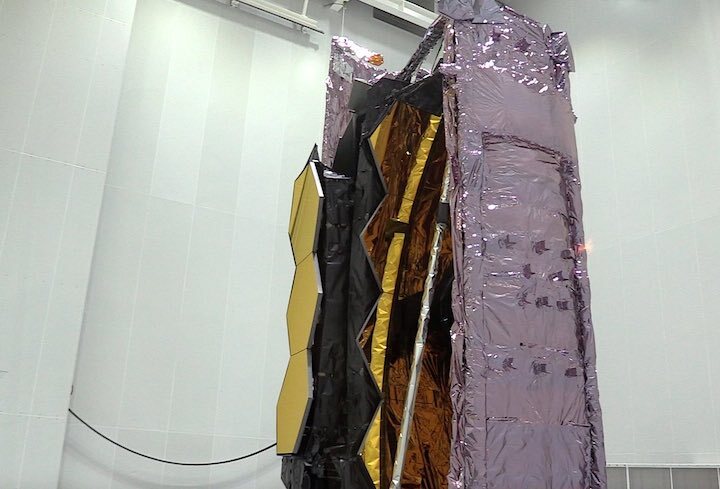
NASA engineers have cleared teams at the Guiana Space Center in South America to begin loading 63 gallons of fuel and oxidizer into the James Webb Space Telescope, after extra testing showed the observatory suffered no damage during a processing incident in the clean room earlier this month.
During a “consent to fuel” review held Wednesday, Nov. 24, mission managers gave approval to begin the propellant loading process at the French Guiana spaceport the following day.
“Additional testing was conducted this week to ensure the observatory’s health following an incident that occurred when the release of a clamp band caused a vibration throughout the observatory,” NASA said in a statement Wednesday.
The start of propellant loading keeps the $9.7 billion James Webb Space Telescope on track for liftoff Dec. 22 aboard a European Ariane 5 rocket. The half-hour launch window opens at 7:20 a.m. EST (1220 GMT; 9:20 a.m. French Guiana time).
The propellant loading operations inside the S5B fueling cell at the Guiana Space Center will take about 10 days to complete, according to NASA. The 10-day period includes steps to prepare, purge, and pressurize elements within the spacecraft bus, the lower section of the 35-foot-tall (10.66-meter) observatory.
The propellant loading itself will occur over several hours on two separate days, mission team members told Spaceflight Now.
The Webb telescope’s spacecraft bus, built by Northrop Grumman, will be filled with 42 gallons (159 liters) of hydrazine and 21 gallons (79.5 liters) of dinitrogen tetroxide, a mix of storable fuel and oxidizer to feed the mission’s 20 rocket thrusters, according to Mark Voyton, NASA’s launch site manager for Webb.
Four of the small engines — a primary and redundant thruster in two pods — will consume fuel and oxidizer for major course correction maneuvers. Webb has eight more thruster modules, each with two small hydrazine-fed engines to nudge the observatory with a single pound of thrust, providing pointing control in concert with spinning reaction wheels inside the spacecraft.
Ground teams wearing self-contained protective suits will be inside the clean room during loading of the toxic propellants. Technicians will also load helium pressurant into the spacecraft.
Webb’s spacecraft bus provides propulsion, electrical power, and communications for the observatory.
NASA announced last week that Webb’s launch was delayed from Dec. 18 to Dec. 22 after managers ordered additional testing on the spacecraft.
The space agency said a “sudden, unplanned release” of a clamp band sent a vibration through the observatory Nov. 9, when technicians were mating Webb to its launch vehicle adapter, a device that connects the observatory with the upper stage of the Ariane 5 rocket.
The adapter’s high-tension clamp band system secures the spacecraft to the rocket until the command to separate Webb about a half-hour after liftoff.
RUAG Space, a Swiss company that specializes in building rocket structures and other components, supplied the payload adapter system for the Ariane 5 rocket and Webb, according to posts on the company’s social media pages.
The processing work inside the S5 payload facility at the Guiana Space Center is being performed under the “overall responsibility” of Arianespace, the French launch services provider for the Ariane 5 program. The European Space Agency, a junior partner on Webb, is paying for the launch as part of its contribution to the mission.
Once fueled, Webb will be transferred to the final assembly building at the spaceport in French Guiana, where a crane will hoist the observatory on top of its Ariane 5 launcher.
The James Webb Space Telescope is folded up in launch configuration to fit inside the Ariane 5 rocket’s 17.7-foot-wide (5.4-meter) payload fairing. Once in space, the observatory will unfurl a power-generating solar panel and a high-gain communications antenna, then start a series of make-or-break deployments of its five-layer sunshield, which will open to the size of a tennis court.
Webb, designed to peer deeper into the cosmos than ever before, has 18 gold-coated beryllium mirror segments that will combine to create the largest telescope mirror ever sent into space, with a diameter of 21.3 feet (6.5 meters). Some of the mirrors are mounted on deployable wings that must fold into place to configure the telescope for science observations.
Then the telescope’s infrared detectors have to cool down to cryogenic temperatures, with parts of the instruments chilled to near absolute zero at a temperature of 7 Kelvin (minus 447.1 degrees Fahrenheit).
The telescope’s mirror segments each have tiny mechanical actuators to adjust focus and alignment. The design makes Webb the most expensive and most complex science mission ever launched into space.
“When you work on a $10 billion telescope, conservatism is the order of the day,” said Thomas Zurbuchen, head of NASA’s science mission directorate.
Quelle: SN
----
Update: 2.12.2021
.
The Biggest ‘Oh No’ Moment in the Solar System
Everything has to go right for the James Webb Space Telescope.
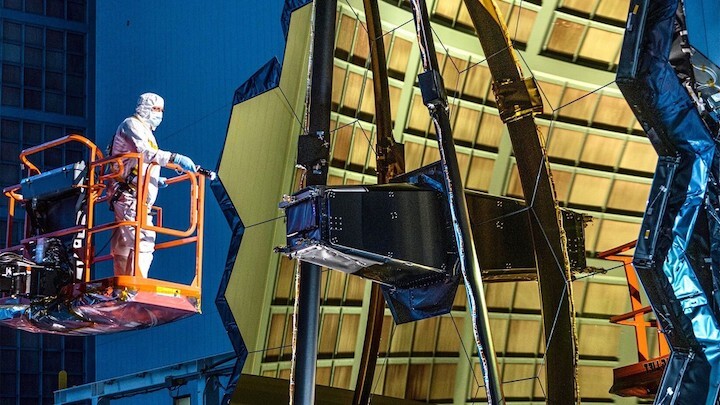
You know that feeling when you’re playing Jenga, and the blocks are stacked remarkably high, and then someone bumps the table? And as the tower wobbles, everyone just watches in wide-eyed panic, willing it to stabilize with a desperate, silent prayer: Please don’t fall, please don’t fall.
I can only assume that’s how it felt last month, when technicians were working on NASA’s new space telescope and a very important clamp suddenly unclamped, sending vibrations coursing through the entire instrument. Officials didn’t provide details about the mood in the room at that moment, but it must have been something along the lines of Oh no, oh no, oh no. This particular Jenga tower is a $10 billion telescope, and NASA has been playing the game for 25 years, carefully arranging piece after piece to produce one of the most sophisticated scientific instruments in human history.
Despite the rogue clamp, the telescope was still very much intact. But engineers had to run extra tests to make sure that the unexpected jolt had not damaged any of its components. A committee established specifically to investigate the incident eventually concluded that the observatory looked fine. The space Jenga was safe.
The space Jenga—er, I mean, the James Webb Space Telescope—is the most powerful space telescope ever constructed. The observatory will peer into the farthest reaches of the universe, revealing the stars and galaxies that formed just after the Big Bang. Perhaps no spacecraft mission has required such tender care since the Hubble Space Telescope, which famously had to be repaired in orbit when NASA realized that the observatory had left Earth with a defective mirror that blurred its view. The Webb telescope is far more complex, and the most harrowing parts of the mission still lie ahead: the rocket launch, yes, but also weeks of careful deployment in space. For Webb to do its job, so much has to go exactly right.
NASA, along with the Canadian Space Agency and the European Space Agency, started working on the telescope back in 1996, several years after Hubble launched. Whereas Hubble was designed to observe the universe in mostly visible and ultraviolet light, Webb was built to soak up the infrared, looking deeper into the cosmos to reveal even more glittering galaxies. Program managers expected the Next Generation Space Telescope, as it was known then, to cost about $500 million and launch in 2007, but over the years, the design grew far more complex than anyone had anticipated. Whole new technologies were invented specifically for the project, and they had to be tested and perfected and then tested again. The longer the project dragged on, the more money it cost. And, to put it gently, mistakes were made. At one point, engineers used the wrong solvent to clean some valves in the observatory’s propulsion system. During one test, dozens of “improperly installed” bolts broke off inside the telescope, sending technicians on a scavenger hunt. These and other errors amounted to months, sometimes years, in schedule delays.
The Webb telescope finally arrived at its launch site on the northeastern coast of South America—near the equator, where Earth’s spin will give the payload an extra boost—in October of this year. Barring any more surprises, the observatory is scheduled to blast off on the morning of December 22. “It’s just nerve-racking,” Caitlin Casey, an astronomer at the University of Texas at Austin, told me. “You don’t want it to launch yet if it’s not absolutely safe. At the same time, you just want it to go, because you know what a powerful tool it’ll be.” Casey and her colleagues have received the biggest chunk of observing time in Webb’s first year of operations, and will study thousands of the earliest galaxies in the universe, too faint for any current telescopes to spot now.
And the rocket launch to space isn’t even the most stressful move. After Webb leaves the launchpad, it will take about a month to travel to its final destination, 1 million miles from Earth. On the way there, JWST must deploy itself piece by piece. The observatory is too big to fit into any existing launch vehicles, so it will leave folded up and then unfurl in space, like a flower blooming in spring, revealing its shiny, gold-covered mirrors to the universe.
All kinds of components must deploy in just the right order, especially those that make up the observatory’s sunshield. The shield, about the size of a tennis court, consists of five layers of aluminum-coated material, which are unpredictable, Mike Menzel, the mission’s lead systems engineer at NASA’s Goddard Space Flight Center, told reporters in a press conference in early November. NASA has unfurled rigid pieces of hardware in space before, but not something as floppy as this sunshield. “We need to make sure that when we deploy, we don’t accidentally snag on any of [the] sensitive components” on the telescope, Krystal Puga, a spacecraft systems engineer at Northrop Grumman, which led the manufacturing of the observatory, said at the same press conference. The sunshield relies on 140 release mechanisms to unfurl, and each “must work perfectly,” Puga said. “They’re all single-point failures."

The observatory overall has 344 of these single-point failures, which are as ominous as they sound. About 80 percent of them are involved in the deployment sequence, Menzel said, which is one of the most complex that NASA has ever attempted. “We’ve built it, we’ve aligned it, we’ve tested it, we proved it worked. Now we’re going to have to break it up, fold it up, and actually rebuild it on orbit—rebuild it, realign it, retune it and get it to work robotically on orbit,” Menzel said. “That’s never been done before.” Engineers have, of course, practiced the various deployments over the years, on both small and full-size models. And NASA has some creative contingency plans if a part glitches in space; engineers can shimmy the observatory, twirl it, even expose it to a little bit of sunlight—anything to jolt it into working. NASA, with its failure-is-not-an-option drive, will no doubt work tirelessly to make the mission a success. But if Webb gets stuck at one of these single-point failures—really, truly stuck—and engineers exhaust all their options, then it’s game over. Unlike Hubble, this telescope was not designed to be repaired. The technology to send astronauts, packed with screwdrivers and bolts, that far from Earth doesn’t yet exist. If something goes terribly wrong, if Webb can’t unspool as planned, humankind’s most powerful space telescope becomes a beautiful $10 billion piece of space junk.
I recently asked NASA, as politely as I could, Why would you do this? Why build something so complicated, with so many opportunities for potential disaster? Menzel, the lead mission systems engineer, said that engineers simply couldn’t avoid single-point failures on a mission that essentially unpacks itself in space. “When you have a release mechanism, it’s hard to put full redundancy into that,” he told me. The final count of 344 single-point failures, Menzel said, was the lowest they could manage.
This intricate process is why the recent incident with the clamp, though alarming, also felt survivable, Johanna Teske, an astronomer at the Carnegie Institution for Science whose team will study exoplanet atmospheres in Webb's first year, told me. “My first reaction was kind of like the gritted-teeth emoji,” Teske said. “My second reaction was: This happened on the ground. This is still a place that we have access to the entire telescope and the instruments, and things can be fixed. It’s a very different story once it’s in space.”
With the unexpected shaking behind them, technicians have now begun fueling Webb’s propulsion systems, which will take the observatory to its orbit and help keep it there. Astronomers around the world are hopeful—what else can they be at this point? They have faith in the people who have worked on the telescope’s hardware over the years, putting the pieces in place. “As an astronomer, I don’t know the ins and outs of how these engineering problems are fixed. Could I tell you what the clamp is? Absolutely not,” Casey said. But the astronomy community, she said, trusts the engineers. “They know how high the stakes are,” she said.
Quelle: The Atlantic
----
Update: 4.12.2021
.
Our team and partners are working side by side to prepare @NasaWebb/@ESA_Webb
and our #Ariane5 for Flight #VA256! Only 19 days to go before liftoff!
It’s always a thrilling moment when we stencil a mission patch on the fairing of our #Ariane5…
We sure can’t wait for December 22!
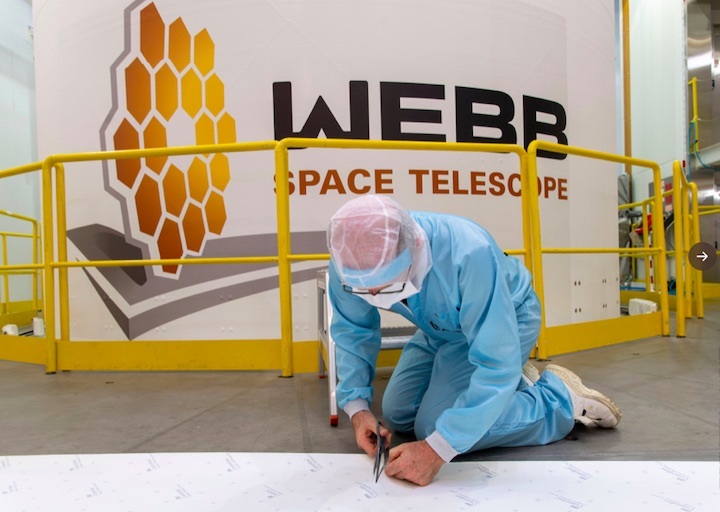
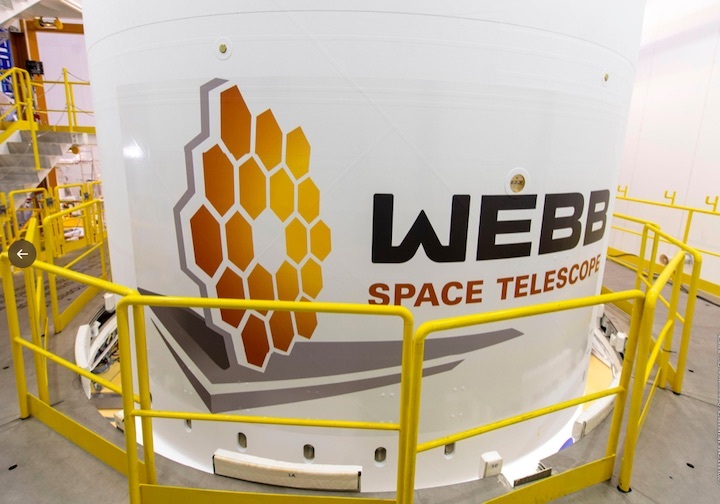
Webb fuelled for launch
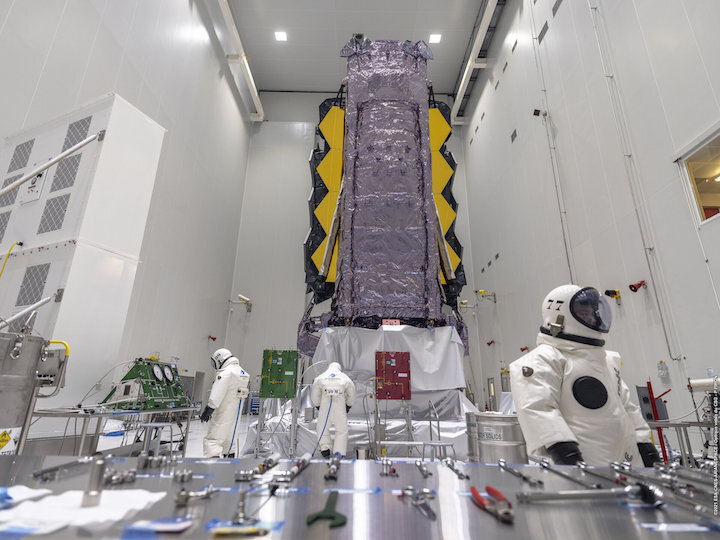
The James Webb Space Telescope was fuelled inside the payload preparation facility at Europe’s Spaceport in French Guiana ahead of its launch on Ariane 5.
Webb’s thrusters will use this propellant to make critical course-corrections after separation from Ariane 5, to maintain its prescribed orbit about one and a half million kilometres from Earth, and to repoint the observatory and manage its momentum during operations.
Fuelling any satellite is a particularly delicate operation requiring setup of the equipment and connections, fuelling, and then pressurisation.
Webb’s propellant tanks were filled separately with 79.5 l of dinitrogen tetroxide oxidiser and 159 l hydrazine. Oxidiser improves the burn efficiency of the hydrazine fuel.
These propellants are extremely toxic so only a few specialists wearing Self-Contained Atmospheric Protective Ensemble, or ‘scape’ suits, remained in the dedicated fuelling hall for fuelling which took 10 days and ended on 3 December.
The next steps will start soon for ‘combined operations’. This is when specialists working separately to prepare Webb and Ariane 5 will come together as one team. They will place Webb atop its Ariane 5 launch vehicle and encapsulate it inside Ariane 5’s fairing.
Then, no longer visible, Webb, joined with its Ariane 5 launch vehicle will be transferred to the Final Assembly building for the final preparations before launch.
Webb will be the largest, most powerful telescope ever launched into space. As part of an international collaboration agreement, ESA is providing the telescope’s launch service using the Ariane 5 launch vehicle. Working with partners, ESA was responsible for the development and qualification of Ariane 5 adaptations for the Webb mission and for the procurement of the launch service by Arianespace.
Webb is an international partnership between NASA, ESA and the Canadian Space Agency (CSA).
NASA Invites Public to Share Excitement of Webb Space Telescope Launch
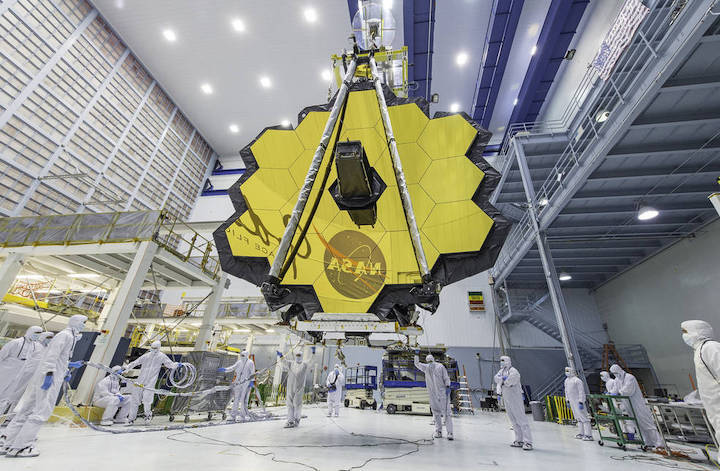
NASA is inviting the public to take part in virtual activities and events ahead of the launch of the James Webb Space Telescope. Webb will be the world’s largest and most powerful space science observatory. It will build upon the discoveries of other missions to answer fundamental questions about the universe and its origins. Launch is scheduled for no earlier than Wednesday, Dec. 22, at 7:20 a.m. EST on an Ariane 5 launch vehicle from French Guiana.
Members of the public may register to attend the launch virtually or RSVP to the Virtual NASA Social event on Facebook. NASA’s virtual guest program for this launch includes curated launch resources, a behind-the-scenes look at the mission, and a virtual guest passport stamp following a successful launch. NASA and contractor employees can register for a special ticket type and receive content designed to honor their contributions.
Live countdown commentary and launch broadcast will begin at 5:50 a.m. EST and air on NASA Television and the agency’s website, as well as YouTube, Twitter, Facebook, LinkedIn, Twitch, Daily Motion, Theta.TV and NASA’s App.
The James Webb Space Telescope’s revolutionary technology will study every phase of cosmic history – from within our solar system to the most distant observable galaxies in the early universe. Webb’s infrared telescope will explore a wide range of science questions to help us understand the origins of the universe and our place in it.
Members of the public also can share in the journey through a variety of activities, including:
Webb STEAM Virtual Platform
The public can learn from experts about Webb, the next great space science observatory. Participants may listen to pre-recorded talks about the critical three-week period after launch, when engineers will command the observatory to unfold for use in space; listen to a Webb audiobook; learn how Webb will extend the scientific discoveries of other NASA missions, starting with the release of stunning images six months after launch; and more. Access the content here: https://go.nasa.gov/WebbSTEAMDay
#UnfoldTheUniverse Art Challenge
Get inspired and show us what you think Webb will discover, using any form of art. Share a photo or video of you with your art and tag us with #UnfoldTheUniverse. You may be featured on our website, social media channels, or historic launch broadcast! Learn more here: https://go.nasa.gov/unfoldtheuniverse
Webb's Deployments
When it comes to the Webb Space Telescope, launch is only the beginning.
In the 29 days after liftoff, thousands of parts must work correctly, in sequence, to ensure that Webb can unfold into its final form. And as all of this takes place, Webb will fly through the expanse of space to a destination nearly one million miles away. Explore all the parts involved in deployment to learn more about Webb’s operational configuration. Explore more: https://jwst.nasa.gov/content/webbLaunch/deploymentExplorer.html
Virtual Launch Passport
Print, fold, and get ready to fill your recently updated virtual passport. Stamps will be emailed following launches to those who register via email through Eventbrite.
Watch and Engage on Social Media
Stay connected with the mission on social media and let people know you’re following the launch and mission on Twitter, Facebook, and Instagram with #UnfoldTheUniverse. Follow and tag these accounts:
Webb is an international partnership between NASA, ESA (European Space Agency), and the Canadian Space Agency. Thousands of engineers and scientists worked to make Webb a reality along with over 300 universities, organizations, and companies from 29 U.S. states and 14 countries.
Additional information about the Webb mission can be found on the mission’s websites: www.nasa.gov/webb and www.webb.nasa.gov
Quelle: NASA
----
Update: 14.12.2021
.
The James Webb Space Telescope: Looking back towards the beginning of time
In 1990, NASA launched the Hubble Space Telescope. It had faced years of delays and cost overruns, but it proved the existence of black holes, calculated the age of the universe, and delivered astonishing views of deep space.
But now, NASA has built something 100 times more powerful, capable of seeing stars so distant, their light has been traveling for nearly 14 billion years, since just after the Big Bang. It's the most ambitious, complex space observatory ever built: the James Webb Space Telescope. And it's scheduled to lift off in 10 days.
Scott Willoughby works for Northrup Grumman (which NASA hired to do most of the design and construction), and is the Webb's program manager. "It's got seven times the collecting area, a mirror which collects more light, to see things that are either dimmer or further away," Willoughby explained.
The Webb will see a different kind of light than the Hubble did – the light from very distant, very old stars is infrared light.
"So, we're designing an eye like night vision goggles for the sky, where we're going to find infrared out in the universe," said Willoughby.
The main mirror is made up of 18 gold hexagons, each adjustable. Correspondent David Pogue asked, "Was it made golden for looks?"
"It was not!" Willoughby replied. "Gold reflects infrared."
Now, infrared is a form of heat. So, any warmth from the sun and the Earth would blind this telescope to distant starlight. The telescope can only work if it is super-cold – like space itself. To block out any shred of sunlight, the Webb will deploy a sun shield. It has five layers of a material like Mylar, each one the thickness of a human hair, that will separate the cold side (-400°F) from the hot side (about +200°F), and keep sunlight from ever touching the mirrors' surface.
There's another way to keep a telescope cold, too: "We send it four times further away than the moon; we're one million miles away," Willoughby said. "And with that, we can keep our optics colder."
But you haven't even heard the hardest part. This telescope is three stories tall and as wide as a tennis court – too big to fit into any existing rocket. NASA's solution? Fold it up, like origami.
Pogue said, "This is the part that worries me as a layperson. I mean, how complex is this unfolding process?"
"It's good to be worried!" said Willoughby. "They have things that are called single-point failures, right? This has to move this way, and there's only one of 'em, right? And Webb has over 300 of those."
"Three hundred things that have to go exactly right?"
"Correct."
If even one of them fails, the Webb telescope becomes the Web space junk. A million miles is much too far away to send a repair mission, as we did for the Hubble.
"So, what do you do with those?" Willoughby said. "You test 'em to greater extremes than they'll ever see."
All that additional testing and caution helps explain the telescope's 14 years of delays, and its $9.7 billion price tag.
"Every time we learn something, we had to repeat a series of tests," said Willoughby. "But all of that is because we have to learn on the ground."
Pogue asked, "So, at this point, days away from the launch, how confident are you?"
"Confidence is built, to me, out of, 'Did we do everything that we could possibly have done?' I can confidently say we did everything that we needed to do. We took every piece of it and we did the best we absolutely, possibly could."
If all goes well, then by the summer of 2022, this machine will get down to its work: Science.
NASA's Stefanie Milam, one of the telescope's science officers, said, "JWST is going to rewrite the textbooks. And I think the science that's going to come out of this is mind-blowing.
"We're going to see the first stars and galaxies and understand how the evolution of our universe actually started. We're going to be able to study the atmospheres of planets around other stars that we've never had access to."
Most exciting of all, Milam expects the Webb Telescope to discover things we never even thought to look for, as the Hubble has done many times. "There are going to be things that we aren't prepared for," she said. "We'll have to figure out how to use the telescope in different ways and plan for the unexpected."
After the scheduled launch on December 22, Scott Willoughby will have to wait 29 days to find out if the unfolding worked, and then five months more for the telescope to calibrate and cool down. "So, in the end, it takes us a half-a-year before you'll be reporting on some image that humankind has never seen before in our lives," he said.
"And is that the point where you can finally sleep at night?" Pogue asked.
"Yeah. I'll feel a lot better then!"
Quelle: CBS News
+++
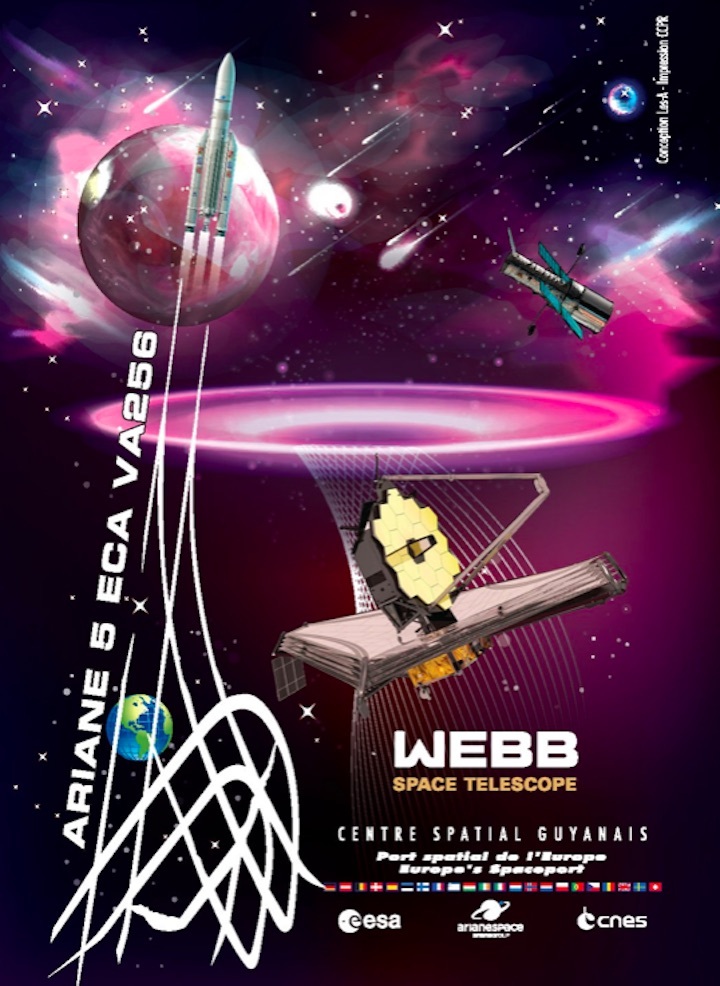
Quelle: arianespace



